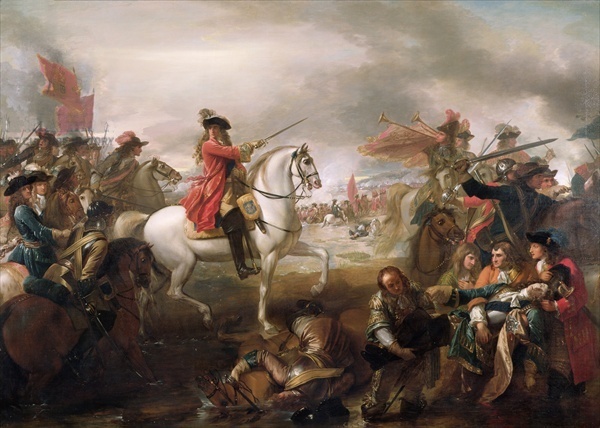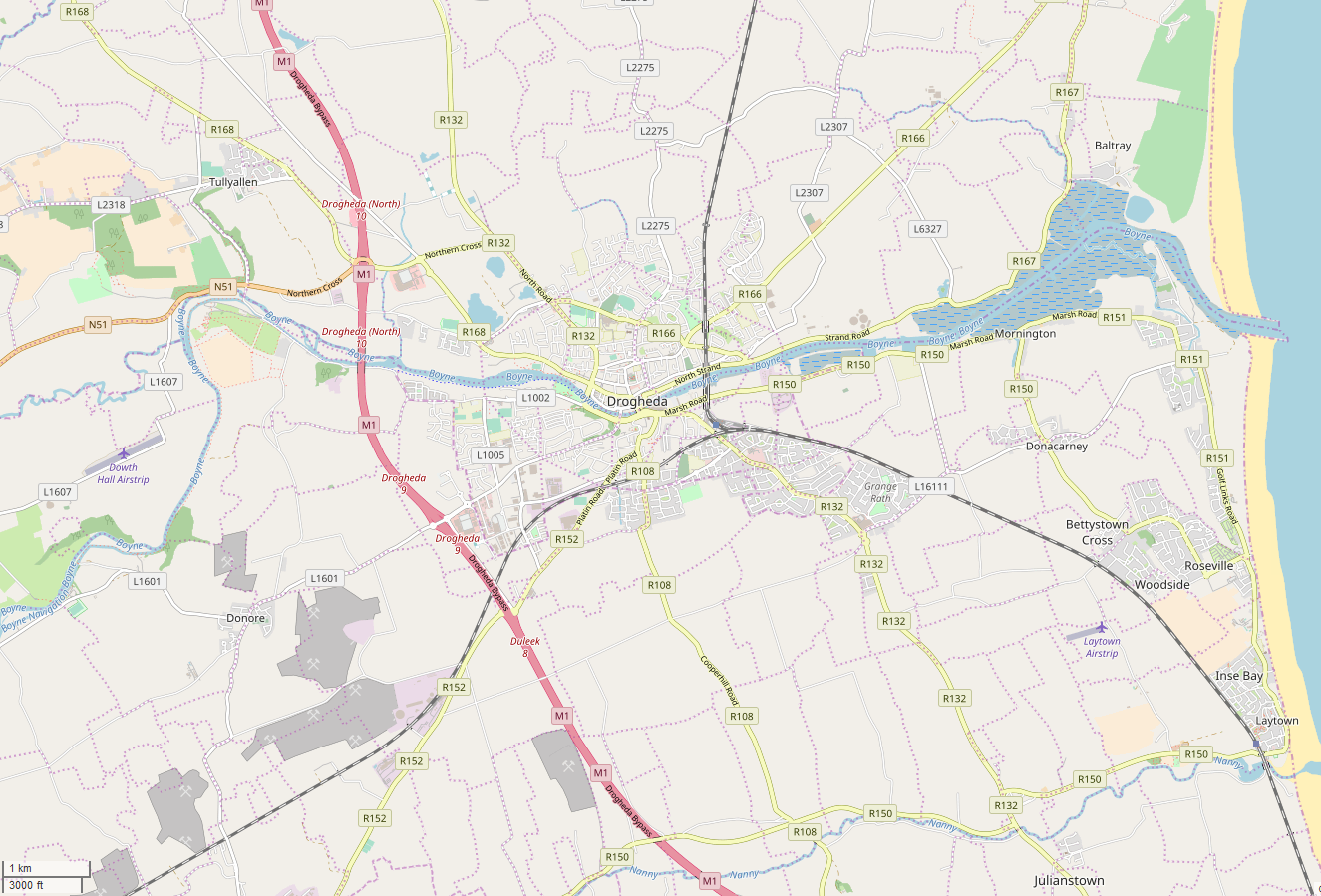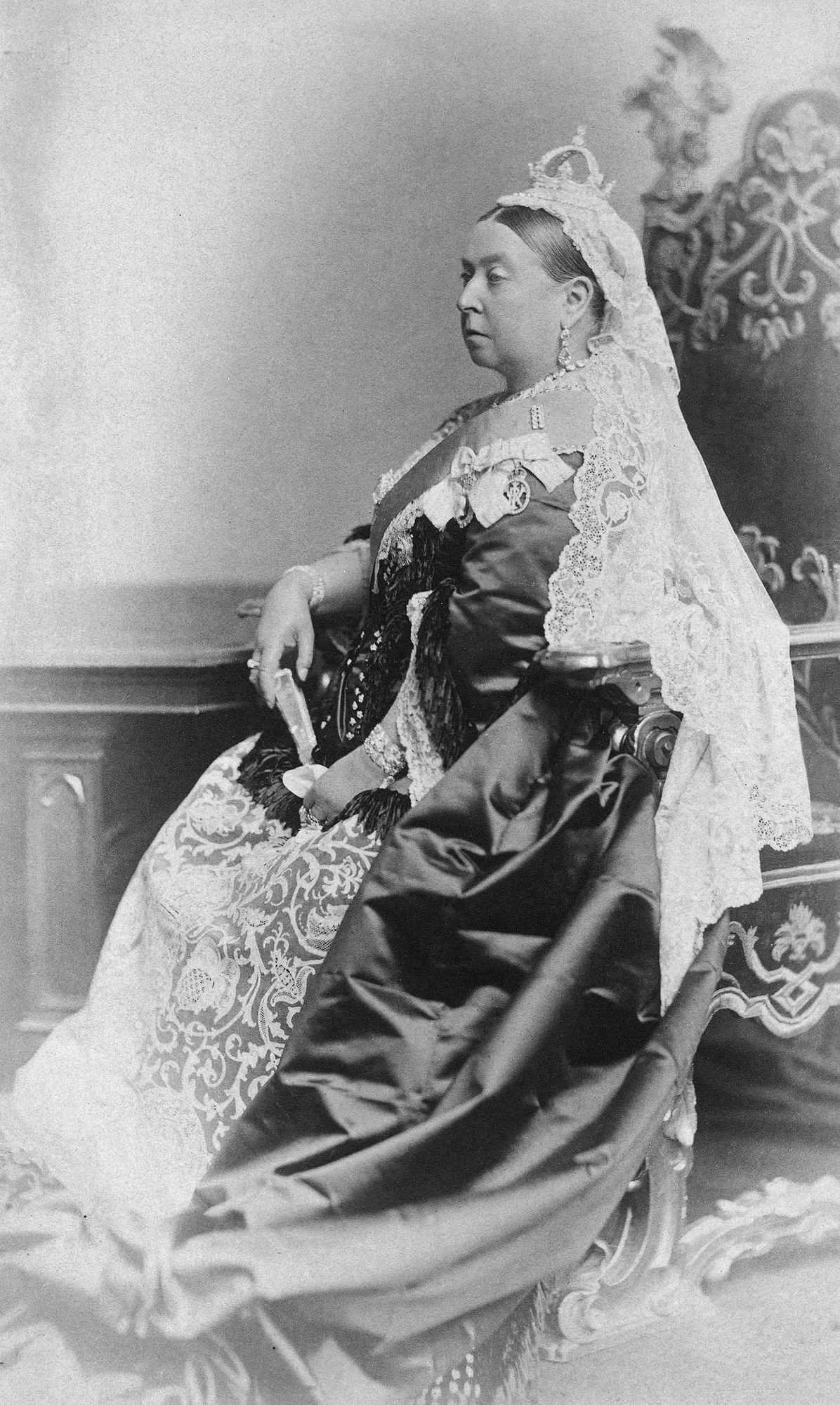|
Battle Of The Boyne
The Battle of the Boyne ( ) took place in 1690 between the forces of the deposed King James II, and those of King William III who, with his wife Queen Mary II (his cousin and James's daughter), had acceded to the Crowns of England and Scotland in 1689. The battle was fought across the River Boyne close to the town of Drogheda in the Kingdom of Ireland, modern-day Ireland, and resulted in a victory for William. This turned the tide in James's failed attempt to regain the British crown and ultimately aided in ensuring the continued Protestant ascendancy in Ireland. The battle took place on 1 July 1690 O.S. William's forces defeated James's army, which consisted mostly of raw recruits. Although the Williamite War in Ireland continued until the signing of the Treaty of Limerick in October 1691, James fled to France after the Boyne, never to return. Background The battle was a major encounter in James's attempt to regain the thrones of England and Scotland, resulting fro ... [...More Info...] [...Related Items...] OR: [Wikipedia] [Google] [Baidu] |
Williamite War In Ireland
The Williamite War in Ireland took place from March 1689 to October 1691. Fought between Jacobitism, Jacobite supporters of James II of England, James II and those of his successor, William III of England, William III, it resulted in a Williamite victory. It is generally viewed as a related conflict of the 1688 to 1697 Nine Years' War. The November 1688 Glorious Revolution replaced the Catholic James with his Protestant daughter Mary II and her husband William, who ruled as joint monarchs of Kingdom of England, England, Kingdom of Ireland, Ireland, and Kingdom of Scotland, Scotland. However, James retained considerable support in largely Catholic Ireland, where it was hoped he would address long-standing grievances on land ownership, religion, and civic rights. The war began in March 1689 with a series of skirmishes between James's Irish Royal Army, Irish Army, which had stayed loyal in 1688, and Army of the North (Ireland), Protestant militia. Fighting culminated in the siege o ... [...More Info...] [...Related Items...] OR: [Wikipedia] [Google] [Baidu] |
Frederick Schomberg, 1st Duke Of Schomberg
Frederick Herman de Schomberg, 1st Duke of Schomberg (6 December 1615 – 1 July 1690) was a German-born army officer who served as the English Master-General of the Ordnance from 1689 to 1690. Having fought in the French, Portuguese, Dutch and English armies, he was killed in action fighting on the Williamite side at the Battle of the Boyne in 1690. Early career Descended from an old family of the Electorate of the Palatinate, he was born at Heidelberg, the son of Count Hans Meinhard von Schönberg (1582–1616) and Anne, a daughter of Edward Sutton, 5th Baron Dudley, and Theodosia Harington. An orphan within a few months of his birth, he was educated by various family friends, among whom was Frederick V, Elector Palatine, in whose service his father had been. He began his military career under Frederick Henry, Prince of Orange, and in 1634 passed into the service of Sweden, entering that of France in 1635. His family, and the allied house of the Saxon Schönbergs, ... [...More Info...] [...Related Items...] OR: [Wikipedia] [Google] [Baidu] |
Treaty Of Limerick
The Treaty of Limerick (), signed on 3 October 1691, ended the Williamite War in Ireland, a conflict related to the Nine Years' War (1688–1697). It consisted of two separate agreements, one with military terms of surrender, signed by commanders of a French expeditionary force and Irish Jacobites loyal to the exiled James II. Baron de Ginkell, leader of government forces in Ireland, signed on behalf of William III and his wife Mary II. It allowed Jacobite units to be transported to France, the diaspora known as the Flight of the Wild Geese. The other set out conditions for those who remained, including guarantees of religious freedom for Catholics, and retention of property for those who remained in Ireland. Many were subsequently altered or ignored, establishing the Protestant Ascendancy that dominated Ireland until the Catholic emancipation in the first half of the 19th century. Background William's victory at the Battle of Boyne in July 1690 was less decisive than app ... [...More Info...] [...Related Items...] OR: [Wikipedia] [Google] [Baidu] |
Protestant Ascendancy
The Protestant Ascendancy (also known as the Ascendancy) was the sociopolitical and economical domination of Ireland between the 17th and early 20th centuries by a small Anglicanism, Anglican ruling class, whose members consisted of landowners, barristers, politicians, clergymen, military officers and other prominent professions. They were either members of the Church of Ireland or the Church of England and wielded a disproportionate amount of social, cultural and political influence in Ireland. The Ascendancy existed as a result of British rule in Ireland, as land confiscated from the Gaelic nobility of Ireland, Irish Catholic aristocracy was awarded by the Crown to Protestantism, Protestant settlers from Great Britain. During the Tudor conquest of Ireland, land owned by Irish nobles was gradually confiscated by the Crown over several decades. These lands were sold to colonists from Great Britain as part of the plantations of Ireland, with the province of Ulster being a Plantati ... [...More Info...] [...Related Items...] OR: [Wikipedia] [Google] [Baidu] |
Republic Of Ireland
Ireland ( ), also known as the Republic of Ireland (), is a country in Northwestern Europe, north-western Europe consisting of 26 of the 32 Counties of Ireland, counties of the island of Ireland, with a population of about 5.4 million. Its capital city, capital and largest city is Dublin, on the eastern side of the island, with a population of over 1.5 million. The sovereign state shares its only land border with Northern Ireland, which is Countries of the United Kingdom, part of the United Kingdom. It is otherwise surrounded by the Atlantic Ocean, with the Celtic Sea to the south, St George's Channel to the south-east and the Irish Sea to the east. It is a Unitary state, unitary, parliamentary republic. The legislature, the , consists of a lower house, ; an upper house, ; and an elected President of Ireland, president () who serves as the largely ceremonial head of state, but with some important powers and duties. The head of government is the (prime minister, ), ... [...More Info...] [...Related Items...] OR: [Wikipedia] [Google] [Baidu] |
Drogheda
Drogheda ( , ; , meaning "bridge at the ford") is an industrial and port town in County Louth on the east coast of Ireland, north of Dublin. It is located on the Dublin–Belfast corridor on the east coast of Ireland, mostly in County Louth but with the south fringes of the town in County Meath, north of Dublin city centre. Drogheda had a population of 44,135 inhabitants in 2022, making it the List of settlements on the island of Ireland by population, eleventh largest settlement by population in all of Ireland, and the largest town in Ireland, by both population and area. It is the second largest in County Louth with 35,990 and sixth largest in County Meath with 8,145. It is the last bridging point on the River Boyne before it enters the Irish Sea. The UNESCO World Heritage Site of Newgrange is located west of the town. Area Drogheda was founded as two separately administered towns in two different territories: Drogheda-in-Kingdom of Meath, Meath (i.e. the Lordship of Mea ... [...More Info...] [...Related Items...] OR: [Wikipedia] [Google] [Baidu] |
River Boyne
The River Boyne ( or ''Abhainn na Bóinne'') is a river in Leinster, Ireland, the course of which is about long. It rises at Trinity Well, Newberry Hall, near Carbury, County Kildare, and flows north-east through County Meath to reach the Irish Sea between Mornington, County Meath, and Baltray, County Louth. Names and etymology This river has been known since ancient times. The Greek geographer Ptolemy drew a map of Ireland in the 2nd century that included the Boyne, which he called (''Bouwinda'') or (''Boubinda''), which in Celtic means "white cow" (). During the High Middle Ages, Giraldus Cambrensis called it the ''Boandus''. In Irish mythology it is said that the river was created by the goddess Boann and Boyne is an anglicised form of the name. In other legends, it was in this river where Fionn mac Cumhail captured Fiontán, the Salmon of Knowledge. The Meath section of the Boyne was also known as ''Smior Fionn Feidhlimthe'' (the 'marrow of Fionn Feilim'). T ... [...More Info...] [...Related Items...] OR: [Wikipedia] [Google] [Baidu] |
Crown And Parliament Recognition Act 1689
The Crown and Parliament Recognition Act 1689 ( 2 Will. & Mar. c. 1) was an act of the Parliament of England, passed in April 1690 but backdated to the start of the parliamentary session, which started on 20 March 1690. It was designed to confirm the succession to the throne of King William III and Queen Mary II of England and to confirm the validity of the laws passed by the Convention Parliament which had been irregularly convened following the Glorious Revolution and the end of James II's reign. The act is still wholly in force in England and Wales (). Reason for the act The act was passed because in 1688 King James II of England was deposed (he was deemed to have abdicated) and replaced as monarch by William and Mary, who ruled jointly. However this could not be achieved without an act of Parliament to approve it. Since no parliament was in existence at the time, it was necessary to convene one, but under the traditional constitution only the monarch could summon ... [...More Info...] [...Related Items...] OR: [Wikipedia] [Google] [Baidu] |
Poynings' Law (on Certification Of Acts)
Poynings' Law or the Statute of Drogheda ( 10 Hen. 7. c. 4 (I) 'The Irish Statutes'' numberingor 10 Hen. 7. c. 9 (I) 'Analecta Hibernica'' numbering later titled "An Act that no Parliament be holden in this Land until the Acts be certified into England") was a 1494 Act of the Parliament of Ireland which provided that the parliament could not meet until its proposed legislation had been approved both by Ireland's Lord Deputy and Privy Council and by England's monarch (the Lord of Ireland) and Privy Council. It was a major grievance in 18th-century Ireland, was amended by the Constitution of 1782, rendered moot by the Acts of Union 1800, and repealed by the Statute Law Revision (Ireland) Act 1878 ( 41 & 42 Vict. c. 57). Background Poynings' Parliament was called by Sir Edward Poynings in his capacity as Lord Deputy of Ireland, appointed by King Henry VII of England in his capacity as Lord of Ireland. Coming in the aftermath of the divisive Wars of the Roses, Poynin ... [...More Info...] [...Related Items...] OR: [Wikipedia] [Google] [Baidu] |
Patriot Parliament
Patriot Parliament is the name commonly used for the Irish Parliament session called by King James II during the Williamite War in Ireland which lasted from 1688 to 1691. The first since 1666, it held only one session, which lasted from 7 May 1689 to 20 July 1689. Irish nationalist historian Sir Charles Gavan Duffy first used the term ''Patriot Parliament'' in 1893. The House of Commons was 70 members short since there were no elections in the northern counties; as a result, its members were overwhelmingly Old English and Catholic. Sir Richard Nagle was elected speaker, while the House of Lords was led by Baron Fitton; the opposition was led by Anthony Dopping, a Church of Ireland cleric who served as the Bishop of Meath. The term is controversial, for this Parliament was deeply divided. The deliberate destruction of its records after 1695 means that assessments, both negative and positive, often rely on individual accounts. Background Despite his Catholicism, James ... [...More Info...] [...Related Items...] OR: [Wikipedia] [Google] [Baidu] |
Mary II Of England
Mary II (30 April 1662 – 28 December 1694) was List of English monarchs, Queen of England, List of Scottish monarchs, Scotland, and Monarchy of Ireland, Ireland with her husband, King William III and II, from 1689 until her death in 1694. She was also List of Princesses of Orange by marriage, Princess of Orange following her marriage on 4 November 1677. Her joint reign with William over Britain is known as that of William and Mary. Mary was born during the reign of her uncle Charles II of England, King Charles II. She was the eldest daughter of James, Duke of York (the future James II of England), and his first wife, Anne Hyde. Mary and her sister Anne, Queen of Great Britain, Anne were raised as Anglicans at the behest of Charles II, although their parents both converted to Roman Catholicism. Charles lacked legitimate children, making Mary second in the Succession to the British throne, line of succession. At the age of 15, she Cousin marriage, married her cousin William of ... [...More Info...] [...Related Items...] OR: [Wikipedia] [Google] [Baidu] |
Glorious Revolution
The Glorious Revolution, also known as the Revolution of 1688, was the deposition of James II and VII, James II and VII in November 1688. He was replaced by his daughter Mary II, Mary II and her Dutch husband, William III of Orange (William III and II), a nephew of James who thereby had an interest to the throne irrespective of his marriage to his cousin Mary. The two ruled as joint monarchs of Kingdom of England, England, Kingdom of Scotland, Scotland, and Kingdom of Ireland, Ireland until Mary's death in 1694, when William became ruler in his own right. Jacobitism, the political movement that aimed to restore the exiled James or his descendants of the House of Stuart to the throne, persisted into the late 18th century. William's invasion was the last successful invasion of England. Despite his own Catholicism, usually an impediment to Protestant support, James became king in February 1685 with widespread backing from the Protestant majorities in England and Scotla ... [...More Info...] [...Related Items...] OR: [Wikipedia] [Google] [Baidu] |







